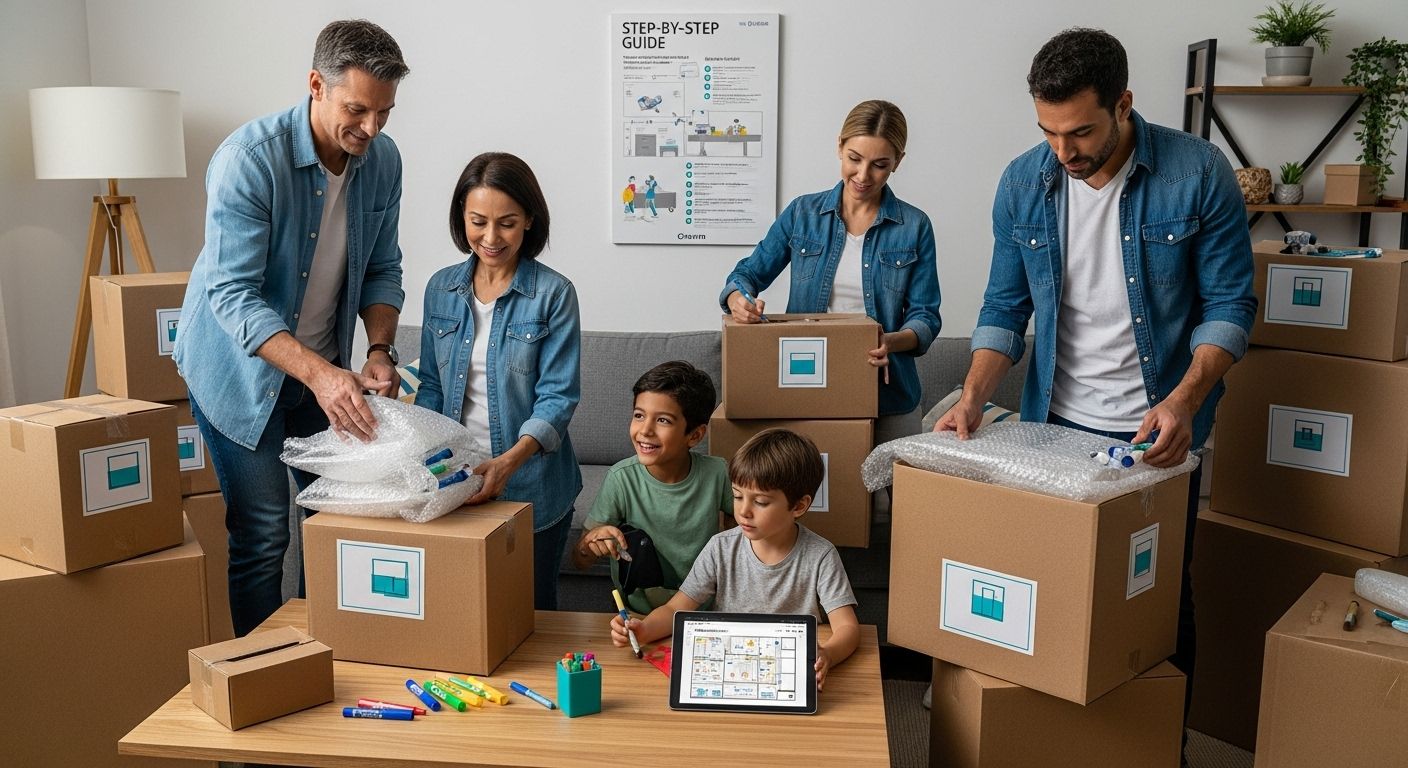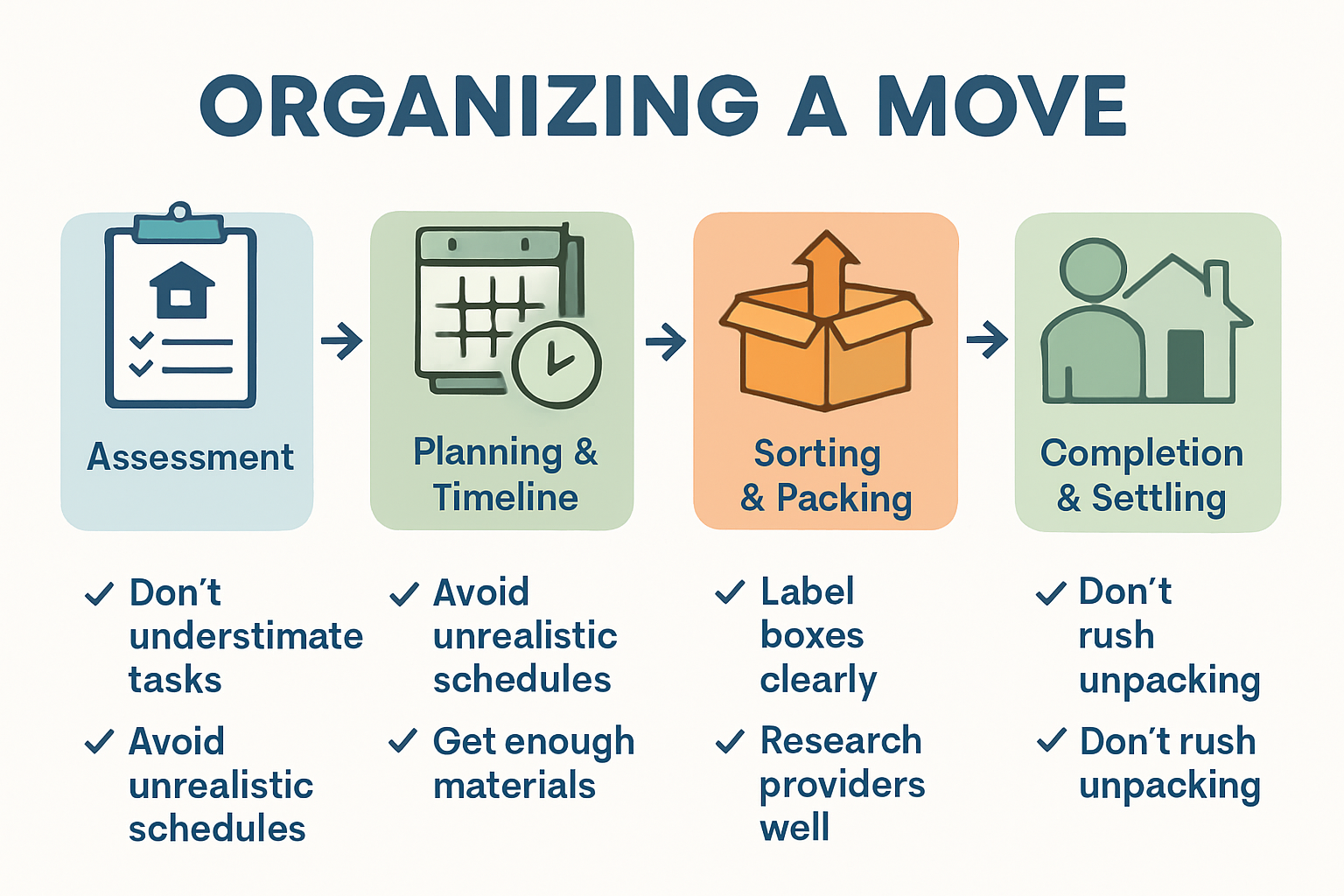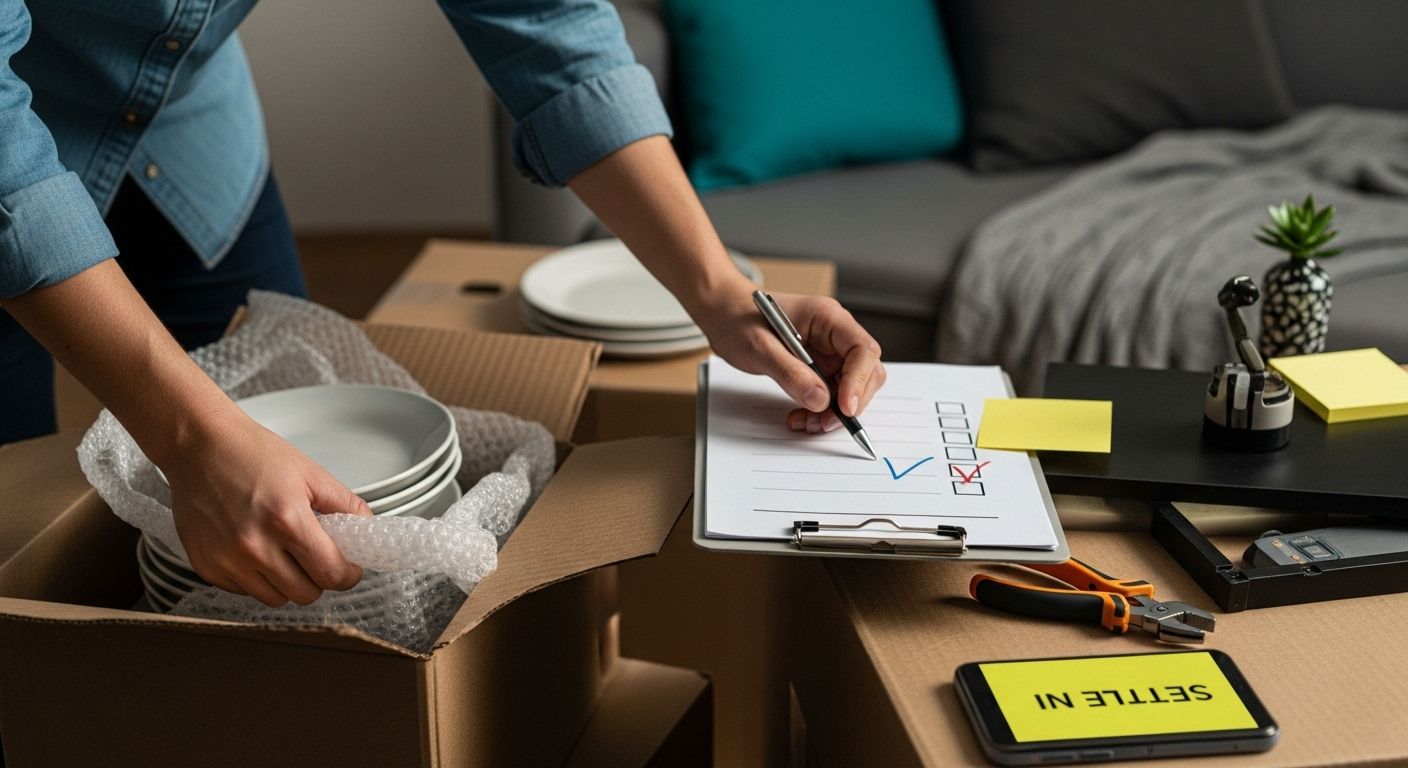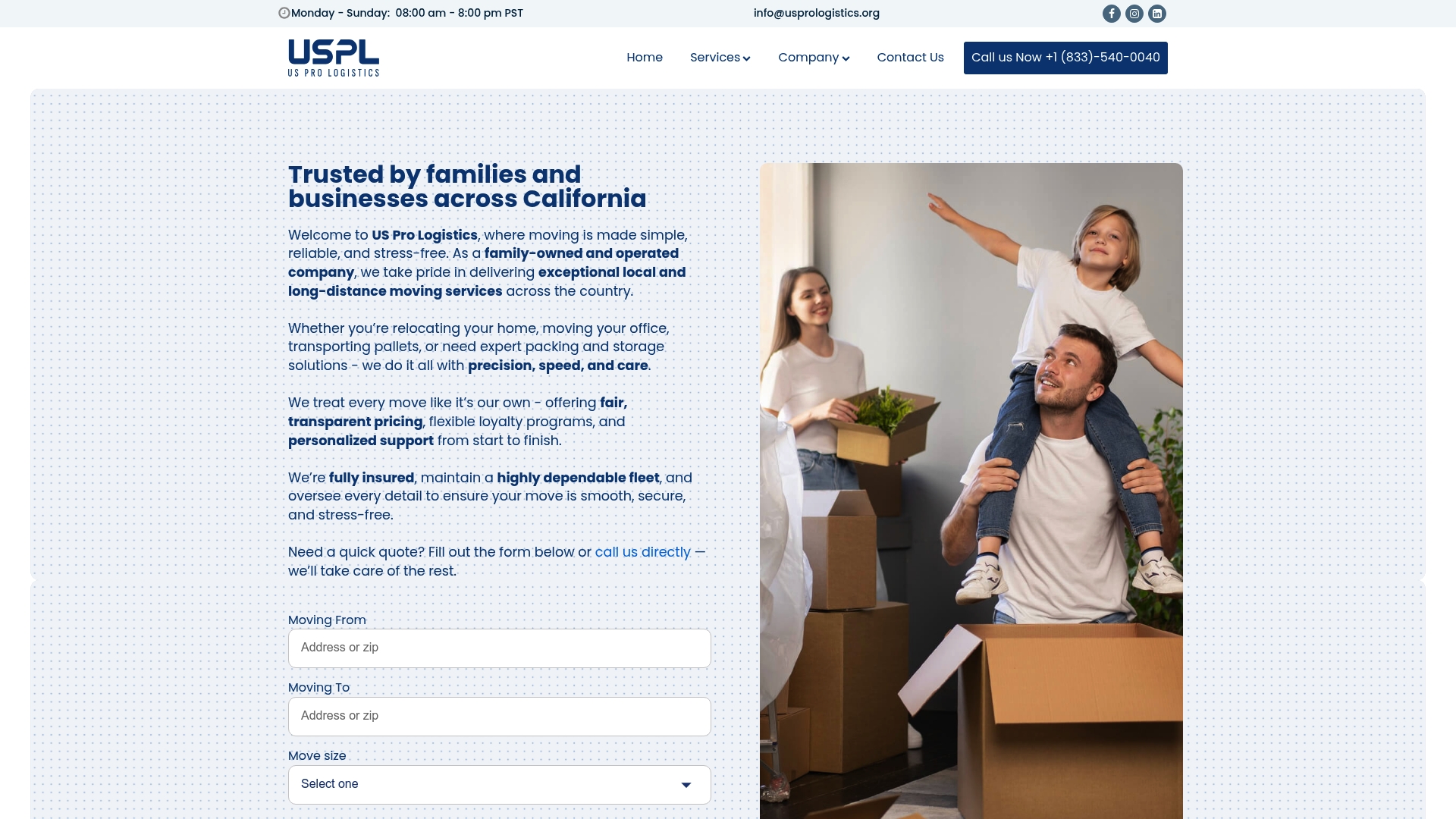
Moving to a new place often sounds simple—just pack your stuff and go. But did you know that most people underestimate the time and complexity by 40 percent, leading to last-minute chaos and stress? Turns out, the biggest challenge isn’t packing boxes at all. The real key is mapping out a detailed plan before you even start sorting, and this one step can change your entire moving experience.
| Key Point | Explanation |
|---|---|
| 1. Assess your current situation thoroughly | Conduct an inventory of belongings and evaluate logistical constraints to create a clear moving snapshot. |
| 2. Create a detailed moving plan and timeline | Develop a structured timeline with milestones for preparation, packing, and transportation to manage tasks incrementally. |
| 3. Gather high-quality moving supplies | Collect essential packing materials and tools to ensure safe transport of belongings and effective organization. |
| 4. Sort and pack strategically | Organize items into categories and pack efficiently, focusing on protection and ease of unpacking at your new home. |
| 5. Verify completion upon arrival | Conduct an inventory check immediately after moving to ensure all items are accounted for and in good condition before settling in. |

Before diving into the complex process of moving, understanding your current situation is crucial. This initial assessment serves as the foundation for a smooth, well-orchestrated relocation. Your goal is to create a comprehensive snapshot of your moving requirements, resources, and potential challenges.
Start by conducting a thorough inventory of your belongings. Walk through each room in your current space, systematically documenting items you plan to move, donate, sell, or discard. This isn’t just about counting boxes - it’s about understanding the volume and complexity of your move. Consider the size of furniture, fragility of items, and special handling needs for things like artwork, electronics, or family heirlooms.
Next, evaluate your logistical constraints. How much time do you have before the move? What is your budget? Are there specific deadlines or time-sensitive requirements? According to the Federal Motor Carrier Safety Administration, creating a realistic timeline is essential for a successful move. Factor in potential complications like work schedules, school transitions, or coordinating with other family members.
Financial preparation is another critical component of your assessment. Calculate moving expenses, including professional movers, packing supplies, transportation costs, and potential storage needs. Create a detailed budget that provides a buffer for unexpected expenses. Some key financial considerations include:
Lastly, assess your personal and emotional readiness for the move. Relocating isn’t just a physical transition but an emotional journey. Consider the psychological impact on yourself and your family. Are there support systems in place? Have you discussed the move with everyone involved? Understanding these emotional dimensions will help you develop strategies to manage stress and maintain a positive outlook throughout the moving process.
By the end of this assessment, you should have a clear, comprehensive understanding of what your move entails. Your documented inventory, timeline, budget, and emotional preparedness will serve as a robust roadmap for the subsequent steps in your moving journey.
With your initial assessment complete, it’s time to transform your insights into a strategic moving plan. A well-crafted timeline is your roadmap to a successful relocation, providing structure and reducing potential stress during this complex process. Your plan will serve as a comprehensive blueprint that guides every subsequent action.
Begin by establishing a central document - preferably a digital spreadsheet or project management tool - where you can track all moving-related tasks. Break down your timeline into distinct phases: preparation, packing, transportation, and arrival. Assign specific deadlines to each major milestone, working backward from your final moving date. This reverse engineering approach helps ensure you’re not overwhelmed and can manage tasks incrementally. Consider creating a comprehensive moving strategy that accounts for potential unexpected challenges.
Your timeline should include critical categories of tasks with specific target completion dates. Allocate ample time for research, booking professional movers, gathering packing supplies, and managing administrative transitions like address changes and utility transfers. Realistic time allocation is key to preventing last-minute panic. For instance, start packing non-essential items 4-6 weeks before your move, reserve specialty packing for fragile items, and create a separate timeline for important documents and valuables.
Key timeline components to prioritize include:
Remember that flexibility is crucial. Build buffer time into your plan to accommodate unexpected delays or complications. Regularly review and adjust your timeline as you progress, treating it as a living document that evolves with your moving journey. By the end of this step, you should have a clear, detailed plan that transforms the abstract concept of moving into a structured, manageable process.
With your moving plan in place, the next critical step is gathering the right supplies and resources to execute your strategy efficiently. Proper preparation prevents poor performance, and this holds especially true when it comes to moving. Your goal is to collect everything you’ll need to pack, protect, and transport your belongings safely and systematically.
Start by acquiring high-quality packing materials. Invest in sturdy moving boxes of various sizes, prioritizing boxes that are clean, structurally sound, and designed for moving. Corrugated cardboard boxes offer the best protection for most items. Supplement these with specialty containers like wardrobe boxes for clothing, dish pack boxes for fragile kitchenware, and document storage boxes for important papers. According to the Federal Motor Carrier Safety Administration, having the right packing materials is crucial for a successful move.
Beyond boxes, gather essential packing supplies like strong packing tape, bubble wrap, packing paper, furniture blankets, and markers for labeling. Consider purchasing a packing kit that includes most of these items, which can be more cost-effective than buying individually. For delicate or valuable items, invest in additional protective materials like foam sheets, stretch wrap, and custom-sized protective sleeves. Padding and protection are your best defense against potential damage during transit.
Essential moving supplies to collect include:
Don’t overlook practical tools that will make your moving process smoother. A utility knife, measuring tape, moving dolly, and hand truck can be invaluable. If you’re doing a DIY move, these tools can significantly reduce physical strain and help you move more efficiently. For those hiring professional movers, understanding the best moving strategies can help you prepare more effectively.
By the end of this step, you should have a comprehensive collection of high-quality moving supplies, organized and ready for packing. Your carefully selected resources will provide the foundation for a well-executed, stress-free move.
Here is a summary table of essential moving supplies and their purposes to help you organize your packing process more efficiently:
| Supply | Purpose |
|---|---|
| Moving boxes (various sizes) | Safely contain and transport belongings |
| Packing tape | Secure boxes and packing materials |
| Bubble wrap | Protect fragile items during transport |
| Packing paper | Cushion items and fill empty box spaces |
| Markers for labeling | Identify box contents and destination rooms |
| Furniture blankets/stretch wrap | Protect and wrap furniture items |
| Specialty containers | Safeguard clothing, dishes, and documents |
| Utility knife & dolly | Assist in cutting tape and moving boxes |
With supplies gathered and a solid plan in place, you’re now ready to tackle the most time-consuming part of moving: sorting and packing your belongings. This step is more than just putting items in boxes - it’s about strategically organizing your life for a smooth transition. Think of this process as an opportunity to streamline your possessions and start fresh in your new space.
Begin by creating a sorting system with four primary categories: keep, donate, sell, and discard. According to Kansas State University’s moving guidelines, decluttering before packing can significantly simplify your moving process. Start in one room and work systematically, making decisive choices about each item. Be ruthless in your assessment - if you haven’t used an item in the past year and it doesn’t hold significant sentimental value, consider letting it go. Your goal is to reduce volume and complexity, making your move more efficient and potentially less expensive.
As you sort, start packing items you’ll definitely be taking with you. Pack room by room, beginning with spaces you use least frequently, like guest rooms or storage areas. Use a color-coding or numbered system for your boxes to track contents easily. Wrap fragile items individually in bubble wrap or soft clothing, placing heavier items at the bottom of boxes and lighter items on top. Fill empty spaces in boxes with packing paper to prevent items from shifting during transport. Remember that strategic packing is about protection and efficiency.
Critical packing guidelines to follow:
Pay special attention to important documents, valuables, and items with sentimental significance. Consider keeping these with you during the move rather than packing them in moving trucks. By the end of this step, you should have systematically sorted your belongings, dramatically reduced unnecessary items, and packed your possessions securely and strategically.
With your belongings sorted and packed, the next crucial step is arranging transportation and essential services for your move. This phase transforms your planning into actual logistics, connecting your current location with your destination. The goal is to create a seamless transition that minimizes stress and potential complications.
Begin by researching and selecting a moving company or transportation method that aligns with your specific needs. According to the Federal Motor Carrier Safety Administration, obtaining estimates from multiple movers and verifying their registration is critical. Request detailed written estimates that include all potential fees, and ask about insurance coverage for your belongings. If you’re doing a DIY move, compare rental truck prices, consider fuel costs, and evaluate additional equipment needs like dollies or moving blankets.
Simultaneously, start managing utility transfers and service disconnections. Contact your current utility providers to schedule final readings and disconnection dates. For your new location, arrange for electricity, water, internet, and other essential services to be activated before your arrival. Timing is crucial to ensure you’re not left without critical services on moving day. Create a comprehensive list of all services that need transfer or setup, including postal mail forwarding, banking address updates, and subscriptions.
Critical services to coordinate include:
Don’t overlook the importance of transportation logistics for yourself and your family. If your move involves significant distance, plan travel arrangements, whether by car, plane, or other means. Learn more about streamlining your moving strategy to make this process smoother. By the end of this step, you should have a clear, confirmed plan for moving your belongings and transferring essential services, setting the stage for a successful relocation.
You’ve navigated the complex journey of moving, and now it’s time to verify the completion of your move and begin settling into your new space. This final stage transforms a collection of boxes and unfamiliar surroundings into a genuine home. The verification process is more than a checklist - it’s about ensuring everything has arrived safely and creating a sense of comfort and belonging in your new environment.
Immediately upon arrival, conduct a thorough inventory check against the documentation you prepared during packing. According to the Federal Motor Carrier Safety Administration, it’s crucial to inspect all items during unloading, documenting any damages or missing items while the moving team is still present. Open boxes systematically, checking for potential damage and comparing contents with your pre-move inventory. Pay special attention to fragile and valuable items, verifying their condition and immediate functionality.
Next, focus on creating functional living spaces. Prioritize setting up essential areas like the bedroom, bathroom, and kitchen. Unpack these rooms first to establish a sense of immediate comfort and routine. Install basic necessities like shower curtains, make your bed, and set up a functional kitchen workspace. Connect major appliances, set up internet and electronic devices, and ensure all utilities are functioning correctly. This approach helps you feel grounded and reduces the overwhelming sensation of being surrounded by countless boxes.
Essential first-day settlement tasks include:
Remember that settling in is a process, not an event. Give yourself grace and time to adjust to the new environment. Unpack methodically, room by room, and don’t feel pressured to complete everything immediately. Explore strategies for a smooth transition to help you adapt more comfortably. By the end of this step, you should feel a sense of accomplishment, with your belongings safely arrived and the initial stages of creating your new home underway.
This checklist table outlines the key settlement tasks to verify completion and help you transition smoothly into your new home:
| Settlement Task | Key Action |
|---|---|
| Verify utility connections | Ensure electricity, water, and internet are working |
| Locate circuit breakers/water valves | Identify emergency shutoff points in your new home |
| Test all major appliances | Confirm proper functioning of refrigerators, stoves, etc. |
| Check locks and security systems | Secure entry points and update codes if necessary |
| Unpack essential boxes first | Set up bedroom, bathroom, and kitchen for comfort |
| Document any damages or missing items | Compare inventory and report to movers |
| Create unpacking/organization plan | Outline which rooms/items to prioritize |

Planning a move is about more than just packing boxes and tracking tasks. The step-by-step guide you just read highlights the emotional strain and logistical headaches that come with inventory management, budgeting, timelines, and the overwhelming need to protect your belongings. It is easy to feel lost in the details or anxious about missing a crucial step. But you do not have to manage all the stress and uncertainty alone. Our team at US Pro Logistics transforms even the most complex moves into organized, stress-free experiences. We offer comprehensive services that bring peace of mind, including tailored residential and commercial moves, expert packing, secure storage, and support for special moves like military and senior relocations. For a closer look at our full range of solutions and booking opportunities, browse our moving services.

Stop letting worry and stress steal your excitement for a fresh start. Trust a dedicated partner that has already helped thousands of families and businesses just like yours move with confidence. Visit US Pro Logistics right now to request your personalized quote or get expert advice tailored to your situation. Take control of your move and see how easy organizing a 2025 relocation can be with the right team on your side.
Start by conducting a comprehensive inventory of your belongings, evaluating your logistical constraints such as time and budget, and considering your emotional readiness for the move.
Your moving plan should include a central document to track moving tasks, a breakdown of distinct phases (preparation, packing, transportation, and arrival), and specific deadlines for critical tasks like utility transfers and packing.
You will need sturdy moving boxes, packing tape, bubble wrap, furniture blankets, and markers for labeling, as well as practical tools like a utility knife and moving dolly. Investing in high-quality materials is key to protecting your belongings during the move.
Create a sorting system with four categories: keep, donate, sell, and discard. Pack room by room, label boxes clearly, and use protective materials for fragile items. Prioritize packing items you use least frequently first to make the process smoother.
USDOT 3664256 This number is required for any company that operates commercial vehicles in interstate commerce (across state lines). It helps identify and track the safety performance and compliance of transportation companies.
MC 1268070 This number is specifically for companies involved in the transportation of goods or passengers for hire across state lines. It’s necessary for carriers operating in the moving industry and ensures they are authorized to operate as interstate carriers.